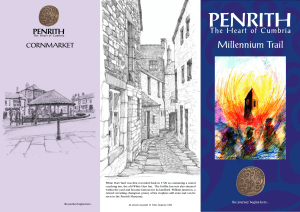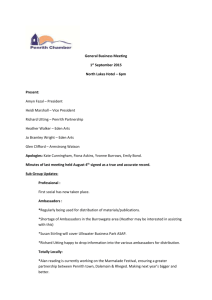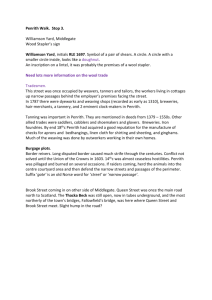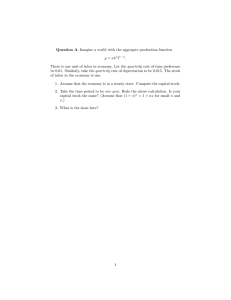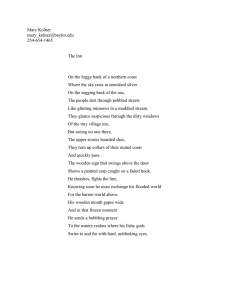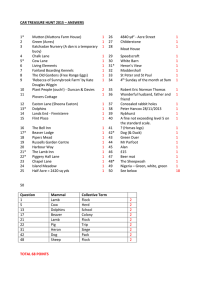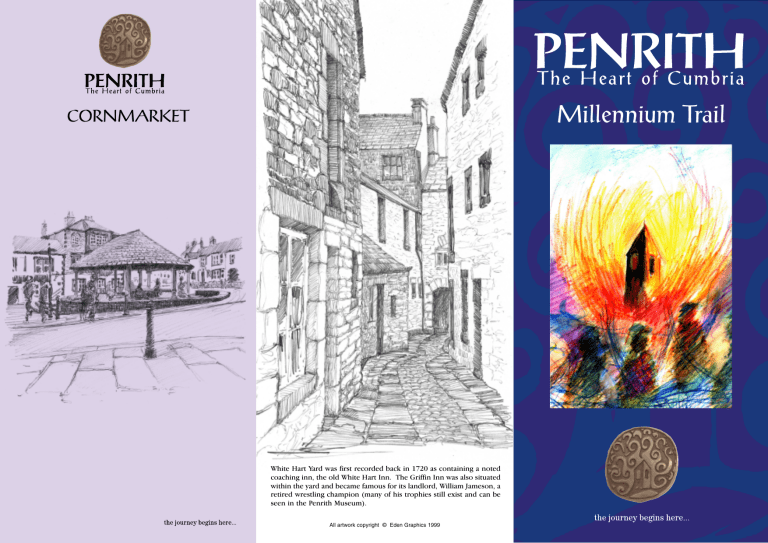
Millennium Trail CORNMARKET White Hart Yard was first recorded back in 1720 as containing a noted coaching inn, the old White Hart Inn. The Griffin Inn was also situated within the yard and became famous for its landlord, William Jameson, a retired wrestling champion (many of his trophies still exist and can be seen in the Penrith Museum). All artwork copyright © Eden Graphics 1999 - allow minimum 30 minutes 1 Musgrave Monument was built in remembrance of Philip, son of Sir George and Lady Musgrave. 2 Cornmarket was the site of many inns central to the trading of all types of commodity. Landlords were also farmers, joiners, slaters, dealers in butter, bacon, cattle and tea, a coal merchant, monumental mason, stone quarry owner and veterinary surgeon. Barley was sold outside the Griffin, oats by the White Hart and wheat at the Black Lion (note date stone on the present Board and Elbow 1624). In 1907 it was recorded that the population of Penrith was 9,182 with 57 licensed houses in the town. Today beer is sold once more in the Black Lion premises, part of the Board and Elbow, but of the other five hostelries not one survives. Across the road from the Black Lion was the Black Bull (now Zebedee Pine) and in the mid 19th century the innkeepers were corn merchants. Like most of the Cornmarket inns, the Black Bull was very old and is mentioned in the 1790 directory when Thomas Murthwaite was the victualler. After him came Joseph Rookin, a maltster and in 1834 the new innkeeper was Joseph Irving. Irving set up a small brewery in the Black Bull in competition with four big breweries in the town. His brew must have been good to stand up to the competition. Strangely, by the end of the century the Black Bull had become a temperance hotel. 3 4 On Cornmarket’s right side, the White Hart, mentioned as early as 1720 was a noted coaching inn with coaches arriving and departing twice daily to and from West Cumberland. Through the archway at the side of the former inn runs a lane called White Hart Yard. Adjacent was the Griffin Inn where a former landlord, Mr William Jameson was of great renown as a wrestler. In 1867 The Pall Mall Gazette referred to “A certain gigantic Jameson, of Penrith, who was more like a polar bear on its hind legs in a grey flannel shirt than a human being”. The Griffin was the Mecca to which wrestlers, athletes and sportsmen of all kinds made their way when in Penrith. White Hart Yard is to be a new housing development, retaining its old character. Clint Mill. The mill, originally built for Pattinson and Winter, a local Seed Merchants and millers in 1878, was occupied for the greater part of the twentieth century by Nickerson’s Seed Merchants. In the early by profession and his customers were of the greyhound racing and Cumberland wrestling fraternity. 1990’s it was converted into offices and a gymnasium. CORNMARKET 5 Poets Walk, site of the Fish Hotel, leads to the foot of Castlegate. 6 Market cross, site of one of Penrith’s first gas lamps. In 1850, 57 gas lamps were tended by stokers from Penrith Gas Light and Coke Co. Each evening a stoker ran up the ladder which he carried with him, lit the gas jet from his lantern, slid down the ladder and dashed off to the next lamp. 7 The former Dockray Hall, now the Gloucester Arms, where it is reputed that Richard III as Duke of Gloucester resided. His arms of two boars rampant appear above the main entrance, whilst above the other door are the initials of John de Whelpdale, one of the five original governors of the Queen Elizabeth Grammar School. 8 Great Dockray, the largest of Penrith’s market spaces, is still a street market every Tuesday. In the past it was used, along with Sandgate, for the twice yearly Hiring Fairs, when those farm servants who were not ‘stopping on’ hired themselves to their new employers for the next half year. This transaction was sealed by the giving and taking of a token coin and was as binding as a legal contract, important as a good wage. At the far end of Great Dockray, the Two Lions Inn dating from 1585 was formerly the home of Gerald Lowther, a forbear for the Earls of Lonsdale. 9 It is not certain whether Angel Lane got its name from the Angel Inn (now shoe shop). The Angel was kept by Mary Westmorland for over 40 years. Directly opposite was another old inn The Duke of Cumberland. Ann Pickering, landlady in the 19th century also carried on the trade of tea and coffee dealer. 10 Angel Square, a modern development of traditional shops designed to harmonise with the town centre, was built in 1987. It was about here that the Waggon Horses Inn was situated. For 30 years during the mid 19th century this inn was kept by Henry Gasgarth, a cooper by trade. In 1878 the Exchange Hotel was built by Thomas Hodgson and Andrew Bell as a temperance hostelry. Thomas Hodgson also founded the Cumberland and Westmorland Herald. Yet another inn on this side of the lane was the King of Prussia, first mentioned in 1790. In the early 1820s it was the headquarters of Penrith’s Unanimity Lodge of Freemasons. The landlord was a maltster 11 On the site of The Bewick Coffee House was the Presbyterian Church, opened in 1785, also the site of the ancestral home of the Nelsons of Virginia. Thomas Nelson of Penrith emigrated to Virginia about the year 1705 and his son, Thomas, was one of the signatories of the American Declaration of Independence. 12 The narrow Rowcliffe Lane, only nine feet wide, linked the market place with Netherend (now King Street). There were several yards leading off this narrow street to small courts behind the shops, in which there was perhaps a pump. Wells and pumps both public and private were the only means of obtaining a clean water supply until a public piped system was introduced in 1854. Water for washing clothes was obtained from the River Eamont, at Eamont Bridge, a mile south of the town and transported into Penrith in large barrels between the shafts of a horse drawn cart, to be sold for a half penny a tubfull. 13 In King Street the Robin Hood Inn is where the poet William Wordsworth stayed during 1794-95 nursing his friend Raisley Calvert, who died on 12th January 1795. Also on King Street is the shop front of J Cowper Ltd, Chemist, a business started in 1889 by Joseph Cowper. The adjacent No. 52 between the years 1922-28 was the premises of the first branch office of Barclays Bank in the town.The premises were then taken over by Tom Guest maker of shoes, boots and clogs. His son John subsequently took over the business until 1997. Note the threestorey business premises (Penrith Building Society) standing on the site of a row of stone cottages and shops where the town’s first victim of the Great Plague died in 1597. Some of the victims of the plague were buried in Bishops Yard, the churchyard and others in their own gardens. A relic of those days, the Plague Stone, now stands not far from its original position in the forecourt of the Greengarth Home for the elderly in Bridge Lane, some half mile from the town centre going south towards Eamont Bridge. It is a large block of freestone hollowed in the centre like a trough. It contained some form of disinfecting liquid (probably vinegar) into which the townspeople put their money when paying for farm produce brought in by the country folk. 14 On the site of the present British Heart Foundation shop was a saddle and trunk maker/Wesleyan preacher, Robert Gate. J & J Grahams earlier also occupied these premises. 15 Two hundred years ago James Clarke, landlord of the White Swan (Nat West Bank) would have had an excellent view of the bustling commercial life of the town. “The markets here are disposed in a manner truly astonishing in so small a town, the wheat market is in one part of the town, rye and potatoes in another, oats and pease in another, cattle, horses and hogs have also their distinct markets”. (A Survey of the Lakes: Clarke 1787). POETS WALK STR EET ANGEL IN S CE Former drinking trough and fountain, originally surmounted by a gas street light. ROWC LIFFE LANE KIN GS TRE ANGEL SQUARE CROWN SQUARE PR CORNMARKET ARK E COR Armorial bearing Richard III, Duke of Gloucester. Situated above main entrance to Gloucester Arms. NM LANE T GREAT DOCKRAY START MARKET SQUARE ET 1 2 3 4 5 6 7 8 9 10 11 12 13 14 15 Musgrave Monument Cornmarket White Hart Yard Clint Mill Poets Walk Market Cross Gloucester Arms Great Dockray Angel Lane Angel Square Bewick formerly Presbyterian Church Rowcliffe Lane King Street British Heart Foundation Nat West Bank formerly White Swan
